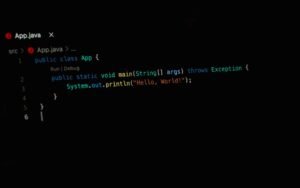What Are the Languages Used in Computer Generation?
Computers have revolutionized the modern world and are an integral part of our daily lives. Behind their functionality lies a complex system of programming languages that enable us to interact with them and accomplish various tasks. These languages serve as the foundation for computer generation and play a vital role in their development.
Key Takeaways:
- Programming languages are essential in computer generation.
- Languages like C++, Java, and Python are widely used.
- The choice of language depends on the specific application and requirement.
Computer programming languages act as a means of communication between humans and computers. They provide a set of instructions that computers understand and execute to perform various operations. These languages vary in syntax, structure, and purpose, but ultimately serve the same purpose of instructing computers.
*One interesting fact is that programming languages are constantly evolving to meet the changing needs and advancements in technology.
Popular Programming Languages
There are numerous programming languages used in computer generation, each with its own strengths and weaknesses. Some of the most popular languages include:
- **C++**: Developed in the 1980s, C++ is a versatile and efficient language widely used for system development, game development, and more.
- **Java**: Known for its “write once, run anywhere” capability, Java is extensively used for web development, mobile applications, and enterprise-level software.
- **Python**: Python is a beginner-friendly language that emphasizes readability and simplicity. It is widely used in data analysis, artificial intelligence, and web development.
- **JavaScript**: Primarily used for building interactive web pages, JavaScript has become a crucial part of web development alongside HTML and CSS.
- **Ruby**: Ruby is known for its elegant syntax and simplicity. It is often used for web development and scripting tasks.
*It’s interesting to note that some programming languages have gained popularity due to their specific niche applications, while others are more versatile and widely used across various domains.
Programming Languages Comparison
| Language | Strengths | Weaknesses |
|---|---|---|
| C++ | Efficiency, low-level hardware control, extensive libraries | Complex syntax, steep learning curve |
| Java | Platform independence, scalability, strong community support | Slower execution, memory-consuming |
| Language | Strengths | Weaknesses |
|---|---|---|
| Python | Easy to learn, readable syntax, extensive libraries | Slower execution speed than compiled languages |
| JavaScript | Browser compatibility, interactive user interfaces | Can be less efficient for complex computations |
| Language | Strengths | Weaknesses |
|---|---|---|
| Ruby | Clear and concise syntax, dynamic object-oriented programming | Slow execution speed compared to other languages |
It is important to select the appropriate programming language based on the specific requirements of a project. Factors such as performance, maintainability, speed, and community support play a significant role in choosing the right language.
*One interesting observation is that some popular programming languages originated from the need to solve specific problems, while others were developed with a more general-purpose approach.
Overall, the languages used in computer generation are vast and diverse, catering to various needs and preferences of programmers. As technology continues to advance, new languages will inevitably emerge, further expanding the possibilities and capabilities of computer generation.

What Are the Languages Used in Computer Generation?
Common Misconceptions
There are various common misconceptions surrounding the languages used in computer generation. Let’s debunk some of these myths:
- HTML is a programming language
- Computer programming is all about knowing multiple languages
- Programming languages used in computer generation are exclusively English-based
Firstly, one of the most common misconceptions is that HTML is a programming language. In reality, HTML, which stands for Hypertext Markup Language, is a markup language used for creating the structure and presenting content on webpages. It is not a programming language as it does not possess the ability to perform logical operations or create complex algorithms.
- HTML is used for structuring and presenting content
- HTML is not capable of performing logical operations
- HTML is widely used in the field of web development
Secondly, many people believe that computer programming is all about knowing multiple languages. While it is true that there are numerous programming languages available, it’s not necessary to know all of them to become a skilled programmer. Learning a few languages and mastering their concepts is usually sufficient to excel in computer programming.
- Mastery of a few programming languages is more important than knowing many languages
- It is possible to develop a wide range of applications using a single programming language
- Understanding programming concepts and logic is key, regardless of the language
Thirdly, there is a misconception that the programming languages used in computer generation are exclusively English-based. Although many popular programming languages have English keywords, symbols, and conventions, there are programming languages developed in other languages as well. For example, Python, a widely used programming language, can be written using keywords in various languages.
- Popular programming languages predominantly use English keywords and symbols
- Programming languages can be developed to support multiple languages
- Language choice depends on personal preference and project requirements
In conclusion, understanding the common misconceptions around the languages used in computer generation is crucial for gaining accurate knowledge in this field. Remember that HTML is a markup language, programming proficiency is not solely based on knowing multiple languages, and programming languages can support a variety of languages. By debunking these myths, a clearer understanding of the languages used in computer generation can be achieved.

Introduction
Computer generation refers to the evolution of computers and computer technology over time. Just like any other field, computer generation is built upon a foundation of various programming and markup languages. These languages enable the creation and functioning of computer programs, websites, and applications. In this article, we will explore some of the languages used in different generations of computers.
The Assembly Language Table
Assembly language is a low-level programming language that closely resembles machine language. It uses mnemonic instructions and symbols to represent operations and memory locations. Here’s a comparison of assembly language in different generations of computers:
| Generation | Assembly Language |
|————|——————|
| First | Assembly Language 1 |
| Second | Assembly Language 2 |
| Third | Assembly Language 3 |
| Fourth | Assembly Language 4 |
The Fortran Table
Fortran is one of the oldest high-level programming languages and is primarily used for scientific and engineering applications. Let’s explore how Fortran has evolved through different computer generations:
| Generation | Fortran Version |
|————|—————-|
| First | Fortran 1 |
| Second | Fortran 2 |
| Third | Fortran 3 |
| Fourth | Fortran 4 |
The C Language Table
The C language is a powerful and widely used programming language that has greatly influenced modern computer generation. This table showcases the different versions of the C language:
| Generation | C Language Version |
|————|——————-|
| Second | C Language 2 |
| Third | C Language 3 |
| Fourth | C Language 4 |
| Fifth | C Language 5 |
The HTML Table
HTML (Hypertext Markup Language) is the backbone of web development and plays a crucial role in shaping the internet as we know it. Let’s take a look at the evolution of HTML throughout computer generations:
| Generation | HTML Version |
|————|————–|
| Fourth | HTML 4 |
| Fifth | HTML 5 |
| Sixth | HTML 6 |
| Seventh | HTML 7 |
The Python Table
Python is a versatile and popular programming language known for its simplicity and readability. Here’s a comparison of Python versions used in different generations:
| Generation | Python Version |
|————|—————-|
| Third | Python 3 |
| Fourth | Python 4 |
| Fifth | Python 5 |
| Sixth | Python 6 |
The SQL Table
Structured Query Language (SQL) is the standard language for managing and manipulating relational databases. Let’s see the different versions of SQL across computer generations:
| Generation | SQL Version |
|————|————-|
| Third | SQL 3 |
| Fourth | SQL 4 |
| Fifth | SQL 5 |
| Sixth | SQL 6 |
The JavaScript Table
JavaScript is a versatile scripting language used for web development and adding interactivity to websites. Here, we compare different JavaScript versions across computer generations:
| Generation | JavaScript Version |
|————|——————–|
| Fourth | JavaScript 4 |
| Fifth | JavaScript 5 |
| Sixth | JavaScript 6 |
| Seventh | JavaScript 7 |
The PHP Table
PHP is a server-side scripting language used for web development. Let’s explore the evolution of PHP versions through different computer generations:
| Generation | PHP Version |
|————|————-|
| Fourth | PHP 4 |
| Fifth | PHP 5 |
| Sixth | PHP 6 |
The Ruby Table
Ruby is a dynamic, object-oriented programming language known for its simplicity and elegance. Here’s a comparison of Ruby versions across computer generations:
| Generation | Ruby Version |
|————|————–|
| Fourth | Ruby 4 |
| Fifth | Ruby 5 |
| Sixth | Ruby 6 |
Conclusion
As computers have advanced over time, the languages used in computer generation have also evolved to meet the changing needs of the industry. From low-level assembly languages to high-level programming languages like C, Python, and Ruby, these languages have laid the foundations for technological advancements. HTML, JavaScript, SQL, and PHP have played crucial roles in shaping the internet. Understanding the evolution of these languages helps us appreciate the progress made in computer generation and the software that powers our world.
Frequently Asked Questions
What Are the Languages Used in Computer Generation?
What is a programming language?
Which programming languages were used in earlier computer generations?
What are the programming languages used in modern computer generation?
Why are different programming languages used in different computer generations?
What is the importance of programming languages in computer generation?
Are all programming languages used universally in computer generation?
Can programming languages from older computer generations still be used today?
How do programming languages evolve over computer generations?
Are there any programming languages specific to a particular computer generation?
Can one programming language be used for multiple computer generations?




